
The Bottom Line
Introduction, Specifications, Pricing and Availability
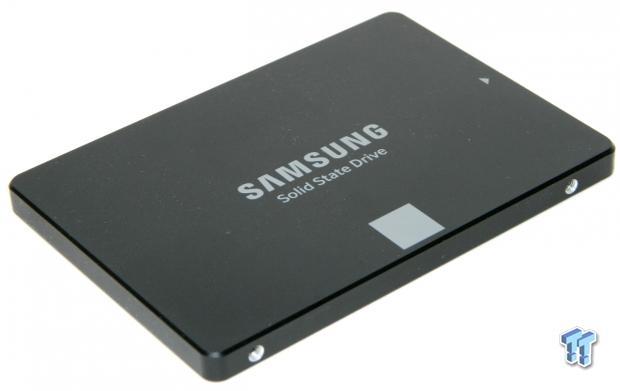
When Samsung launched their 750 EVO back in February of this year, it came in two capacities, 120GB and 250GB. Availability was essentially limited to emerging markets and system integrators. The 750 EVO generated quite a buzz within the enthusiast community because of its superior performance at a low price point. A lot of people wanted to get their hands-on a 750 EVO, but availability was an issue preventing most from acquiring their own. Additionally, capacity points of 120GB and 250GB were not enough for many users, even if they were able to buy one.
Samsung is always quick to respond to the demands of the market place, and last week announced they will expand consumer availability of the 750 EVO worldwide. In addition, Samsung announced a new 500GB capacity point would be added to the 750 EVO lineup. Previously, we tested the 120GB and 250GB 750 EVO's and found the 750 EVO capable of delivering significantly better performance than rival solutions. We were blown away by Samsung's ability pack so much performance into these small capacity SSDs. The only thing we were left wanting for was more capacity. To us, 480GB is the minimum size necessary to satisfy our capacity needs.
Samsung was apparently thinking the same thing, and today offers the 750 EVO at what we feel is a far more attractive capacity point. We feel Samsung's 850 EVO is currently the best performing SATA III SSD on the market. The 750 EVO doesn't unseat the champ, but it is capable of delivering performance that does rival that of the 850 EVO, especially at a 500GB capacity point. In terms of pecking order without price factored in, Samsung (in our opinion) owns the top three spots for SATA III performance. 850 EVO, 850 Pro and now the 750 EVO 500GB; in that order.
One of the things we feel separates Samsung SSDs from the competition is that they always deliver sequential and random performance where it matters most; QD1 and QD2. In fact, Samsung states that the 750 EVO is specifically tuned to deliver class-leading performance at QD1-2. There are lower cost options on the market, but in the case of Samsung's SATA III SSD's you get what you pay for. For a few dollars more you get the return of superior performance; enough additional performance that in most cases you can "feel" the difference.
Samsung's 750 EVO employs a planar flash array whereas the 850 EVO employs a 3D flash array. The 750 EVO's 16nm planar (2D) flash array is more cost effective than 3D flash. This allows Samsung to offer the 750 EVO at a lower price point than the 850 EVO. Like the 850 EVO, the 750 EVO employ's Samsung's proprietary "TurboWrite" SLC caching to boost burst performance. In addition, the latest version of Samsung's Magician software, version 4.9.7, enables RAPID mode on the 750 EVO. For those of you unfamiliar with RAPID, it is Samsung's proprietary caching software that when enabled, allocates a portion of system memory as a cache for your Samsung SSD. This provides greatly improved performance and also extends the overall lifespan of the drive's flash array by sequentializing random data before flushing it to the drive's the flash array.
Additional capacity almost always results in better performance, which means the 500GB 750 EVO should be even faster than the already blazing fast 120-250GB 750 EVO's. Let's take a close look and see if this is the case.
Specifications
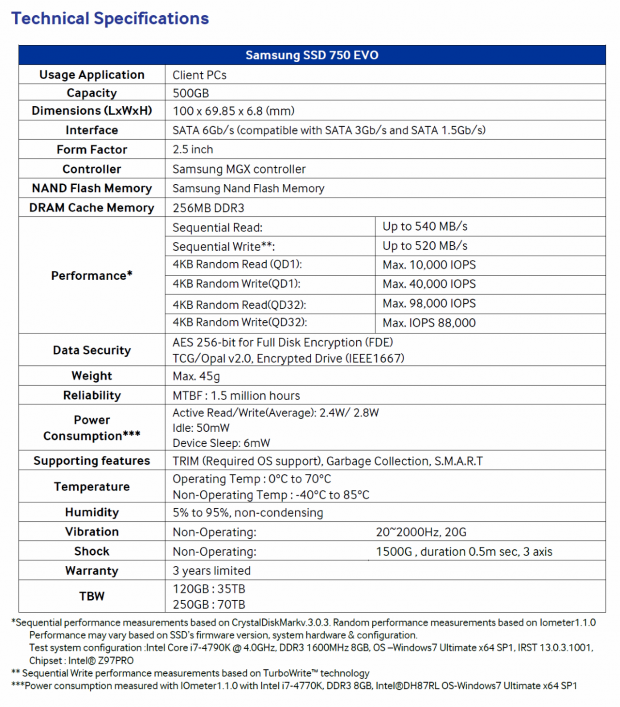
Samsung's 750 EVO 2.5"x7mm SATA III SSD is available in three capacities: 120GB, 250GB and 500GB. The 500GB model we have on the bench has the following factory specifications:
Sequential Read: up to 540 MB/s. Sequential Write: up to 520 MB/s. Max 4K Random Read: up to 98,000 IOPS (QD32). Max 4K Random Write: up to 88,000 IOPS (QD32). 4K QD1 Read: up to 10K IOPS. 4K QD1 Write up to 40K IOPS. MTBF: 1.5 million hours. TBW: 100TB. Power: Active Avg. Read/Write 2.4/2.8W, Idle 50mW, Device Sleep 6mW. Data Security: AES 256-bit for Full Disk Encryption (FDE), TCG/Opal v2.0 Encrypted Drive (IEEE1667). The 500GB 750 EVO carries an MSRP of $149.99.
Drive Details
Samsung 750 EVO 500GB SATA III SSD

The front of the packaging is all white with an image of the enclosed SSD. Capacity is given on the top right corner.
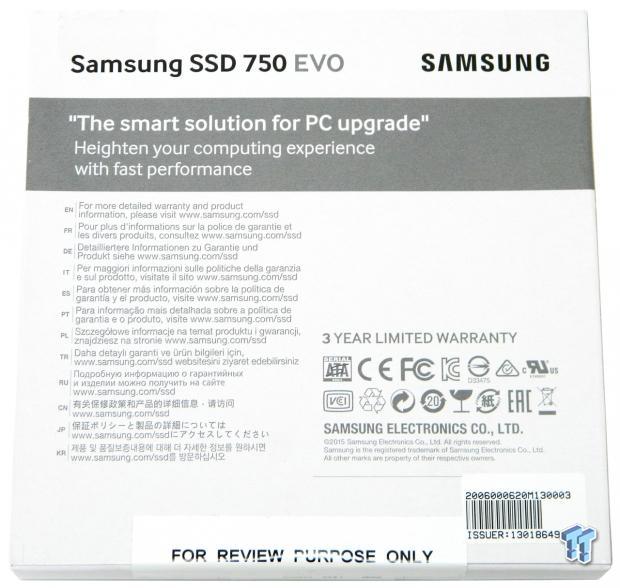
The rear of the all-white packaging informs us that Samsung's 750 EVO is "The smart solution for PC upgrade" and that the drive is covered by a 3-year limited warranty.
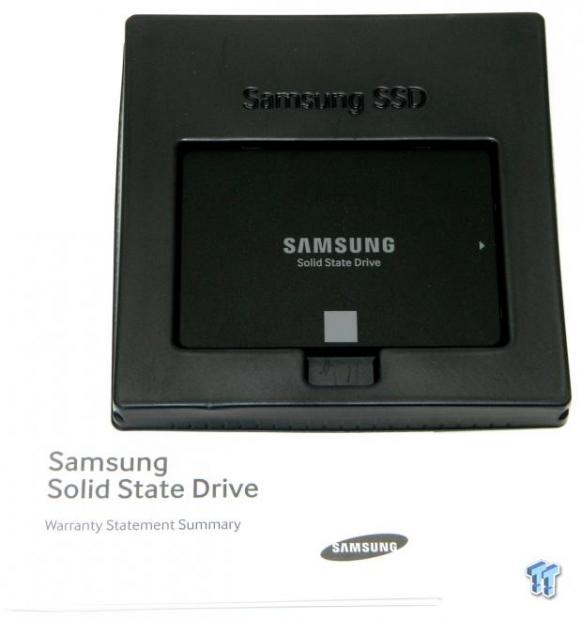
Inside of the packaging, the drive is cradled in a protective plastic tray. Samsung includes a printed warranty statement.
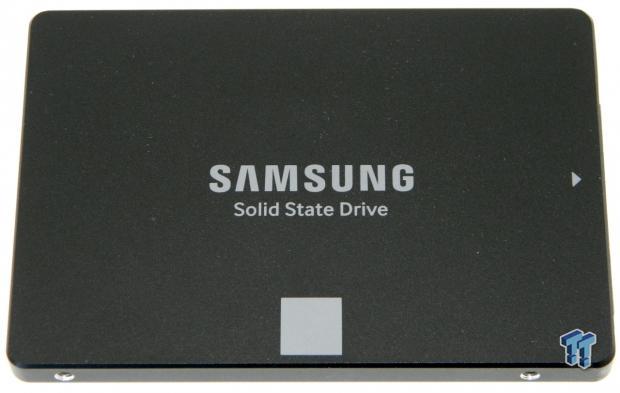
The drive enclosure is typical Samsung; all aluminum with a black finish. Minimalistic and attractive. The grey square denotes that the drive is an EVO series SSD.
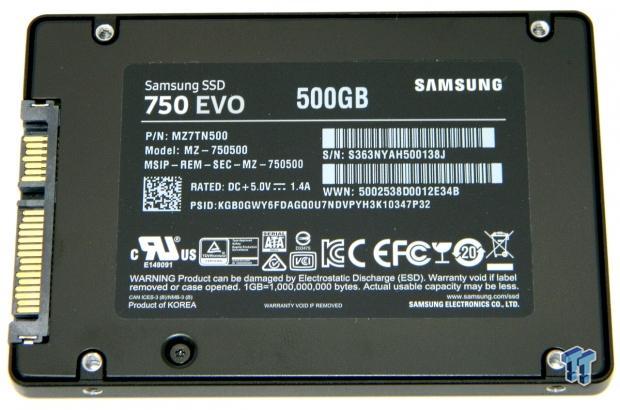
The back half of the drive's enclosure features a manufacturer's label listing the particulars of the drive.

Opening the drive reveals that top half is formed from cast aluminum, the bottom half from sheet aluminum. Both are of excellent quality. The PCB is a reduced size design. The inside of the enclosure is marked as 850 EVO, because both the 750 EVO and 850 EVO models utilize the same enclosure.

This side of the PCB houses the drive's MGX controller, two of its four flash packages, and a single DRAM cache package.
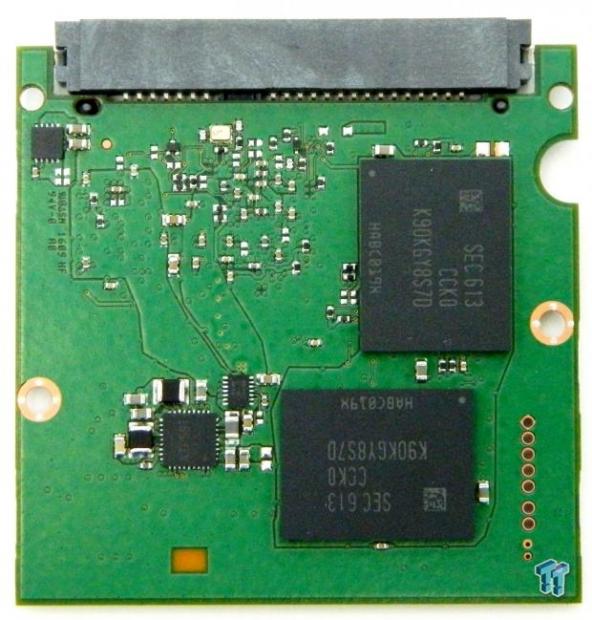
This side of the PCB houses the remaining two flash packages.

A detailed view of the 8-channel MGX controller that powers the 750 EVO.

A detailed view of one drive's four 16nm 128GB 16nm flash packages.

A detailed view of the drive's LPDDR3 1600 MHz cache package.
Test System Setup and Properties
Jon's Consumer SSD Review Test System Specifications
- Motherboard: ASRock Extreme9 Z97 - Buy from Amazon
- CPU: Intel Core i7 4790K @ 4.8GHz - Buy from Amazon / Read our review
- Cooler: Swiftech H2O-320 Edge - Buy from Amazon / Read our review
- Memory: Corsair Dominator DDR3 32GB 2400MHz - Buy from Amazon
- Video Card: Onboard Video
- Case: IN WIN X-Frame - Buy from Amazon / Read our review
- Power Supply: Seasonic Platinum 1000 Watt Modular - Buy from Amazon / Read our review
- OS: Microsoft Windows 10 Professional 64-bit - Buy from Amazon
- Drivers: Intel RAID option ROM version 13.0.0.2075 and Intel RST driver version 13.6.0.1002
We would like to thank ASRock, Crucial, Intel, Corsair, RamCity, IN WIN, and Seasonic for making our test system possible.
Drive Properties
750 EVO 500GB OS Disk 75% Full

The majority of our testing is performed with our test drive as our boot volume. Our boot volume is 75% full for all OS Disk "C" drive testing to replicate a typical consumer OS volume implementation. We feel that most of you will be utilizing your SSDs for your boot volume and that presenting you with results from an OS volume is more relevant than presenting you with empty secondary volume results.
System settings: Cstates and Speed stepping are both disabled in our systems BIOS. Windows High-Performance power plan is enabled. Windows write caching is enabled, and Windows buffer flushing is disabled. We are utilizing Windows 10 Pro 64-bit OS for all of our testing except for our MOP (Maxed-Out Performance) benchmarks where we switch to Windows Server 2008 R2 64-bit.
Synthetic Benchmarks - ATTO & Anvil's
ATTO
Version and / or Patch Used: 2.47
ATTO is a timeless benchmark used to provide manufacturers with data used for marketing storage products.

Compressible sequential read/write transfers max out at 554/528 MB/s, both of which exceed Samsung's listed sequential specifications. Keep in mind this is our OS volume, and it is filled to 75% of its total capacity. Maximum sequential read performance is achieved at a 2MB transfer size, maximum sequential write performance at 512KB transfers.
Sequential Write

The 750 and 850 EVO's perform almost identically dominating the field at transfer sizes of 0.5-16KB. The PNY CS2211 finishes the test with the highest transfer rate.
Sequential Read
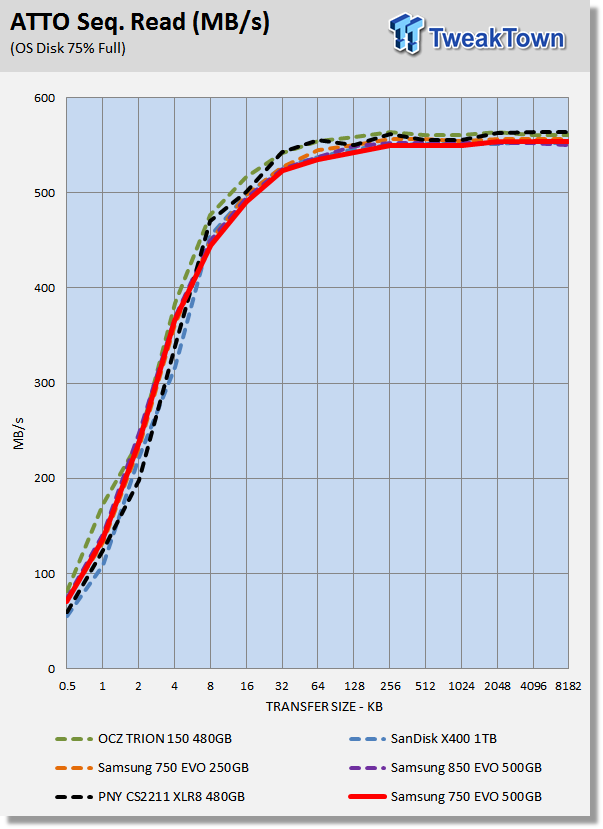
All of the drives in our test pool perform in a similar fashion. Overall, OCZ's TRION 150 delivers the best performance of the bunch.
Anvil Storage Utilities
Version and / or Patch Used: 1.1.0
Anvil's Storage Utilities is a storage benchmark designed to measure the storage performance of SSDs. The Standard Storage Benchmark performs a series of tests; you can run a full test or just the read or write test, or you can run a single test, i.e. 4k QD16.

Scoring
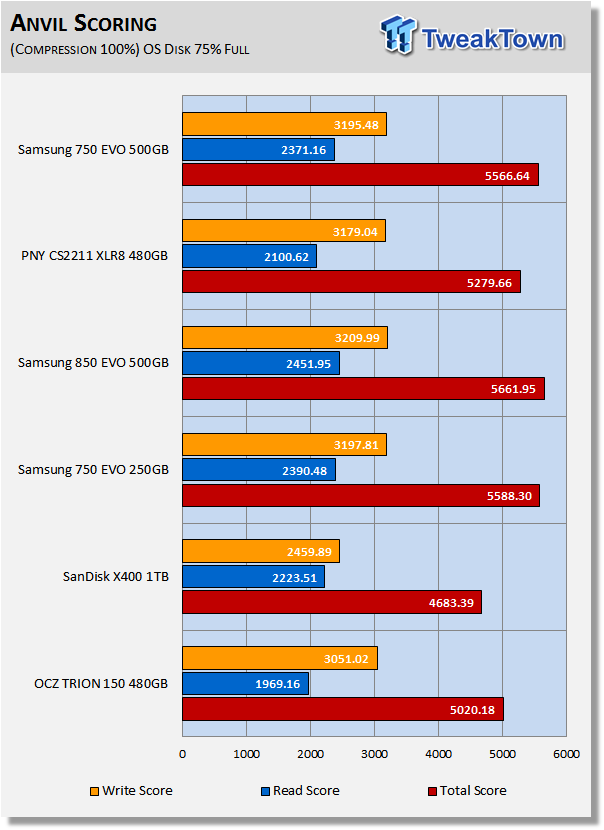
Anvil's scoring gives a good indication of a drive's overall performance. Samsung's EVO series SSDs easily outperform the competing drives in our test pool. The 850 EVO delivers the highest score followed closely by the 250GB and 500GB 750 EVO.
(Anvil) Read IOPS through Queue Depth Scale

The EVO's deliver the highest IOPS, but SanDisk's read-centric X400 delivers better performance from QD4-QD8.
(Anvil) Write IOPS through Queue Scale

Samsung states that their EVO line of SSD's are designed to deliver superior performance at QD1-2 and we can see this fact represented on our chart.
Synthetic Benchmarks – CrystalDiskMark & AS SSD
CrystalDiskMark
Version and / or Patch Used: 3.0 Technical Preview
CrystalDiskMark is disk benchmark software that allows us to benchmark 4k and 4k queue depths with accuracy. Note: Crystal Disk Mark 3.0 Technical Preview was used for these tests since it offers the ability to measure native command queuing at QD4.


We speculated that the 500GB 750 EVO would likely deliver even better performance than the 120 and 250GB models. The 500GB 750 EVO cranks out better random read performance at 4K QD1-4 which will likely translate to better moderate workload performance. We can also see that the 500GB 850 EVO is bit more powerful than the 750 EVO 500GB.

All of the EVO's in our test pool are capable of delivering overwhelming 4K QD1 random write performance which is a key reason why they deliver such fantastic moderate workload performance. If we compare the 500GB 750 EVO to the 250GB 750 EVO, we see that the 500GB model delivers much better random write performance at QD4 and QD32.
AS SSD
Version and / or Patch Used: 1.7.4739.38088
AS SSD determines the performance of SSDs. The tool contains four synthetic as well as three practice tests. The synthetic tests are to determine the sequential and random read and write performance of the SSD.
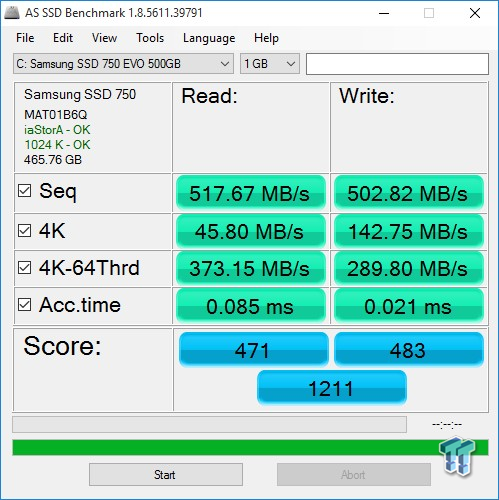
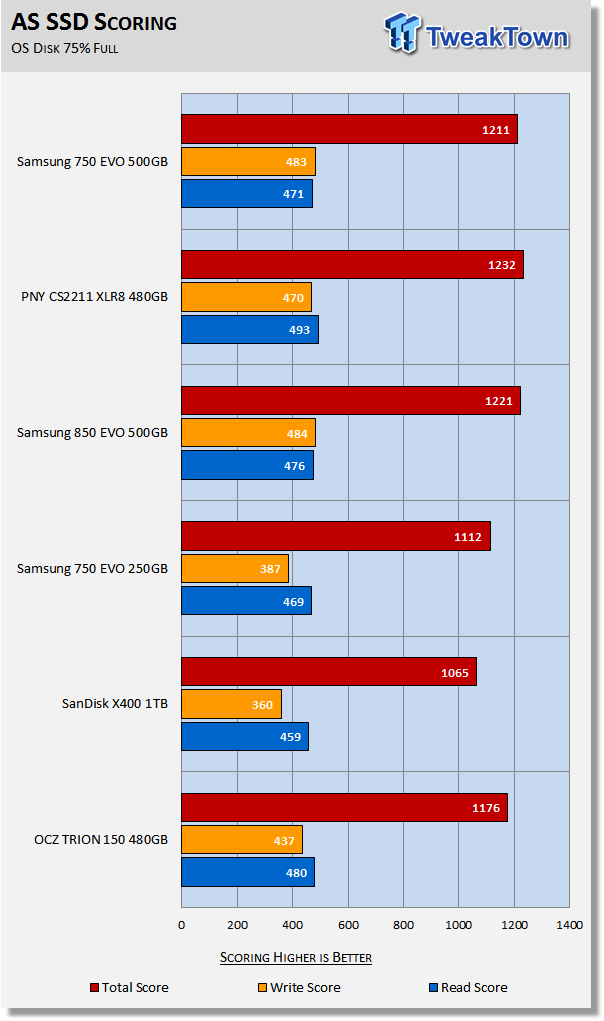
AS SSD is a demanding test and the 500GB 750 EVO does not disappoint. PNY's CS2211 delivers the highest score of the drives in our test pool due to its MLC flash array and the way it digest's AS SSD's data pattern. Again, we can see that the 500GB 750 EVO is indeed more powerful than the 250GB model.
Benchmarks (Trace-Based) - Vantage, PCMark 7 & PCMark 8
Moderate Workload Model
We categorize these tests as indicative of a moderate workload environment.
PCMark Vantage - Hard Disk Tests
Version and / or Patch Used: 1.2.0.0
The reason we like PCMark Vantage is because the recorded traces are played back without system stops. What we see is the raw performance of the drive. This allows us to see a marked difference between scoring that other trace-based benchmarks do not exhibit. An example of a marked difference in scoring on the same drive would be empty vs. filled vs. steady state.
We run Vantage three ways. The first run is with the OS drive 75% full to simulate a lightly used OS volume filled with data to an amount we feel is common for most users. The second run is with the OS volume written into a "Steady State" utilizing SNIA's guidelines. Steady state testing simulates a drive's performance similar to that of a drive that been subjected to consumer workloads for extensive amounts of time. The third run is a Vantage HDD test with the test drive attached as an empty, lightly used secondary device.
OS Volume 75% Full - Lightly Used

OS Volume 75% Full - Steady State

Secondary Volume Empty - FOB

There's a big difference between an empty drive, one that's 75% full/used, and one that's in a steady state.

The important scores to pay attention to are "OS Volume Steady State" and "OS Volume 75% full." These two categories are most important because they are indicative of typical of consumer user states. When a drive is in a steady state, it means garbage collection is running at the same time it's reading/writing. This is exactly why we focus on steady state performance.
PNY's CS2211 delivers the best empty score we've ever recorded. However, empty scores are meaningless which is THE reason we test the way we do. With data on the drives, a different picture emerges and the CS2211 can't deliver anywhere near the performance of the 750 EVO's. The 850 EVO again assert's its dominance over the test pool.
PCMark 7 - System Storage
Version and / or Patch Used: 1.4.0
We will look to Raw System Storage scoring for evaluation because it's done without system stops and, therefore, allows us to see significant scoring differences between drives.
OS Volume 75% Full - Lightly Used

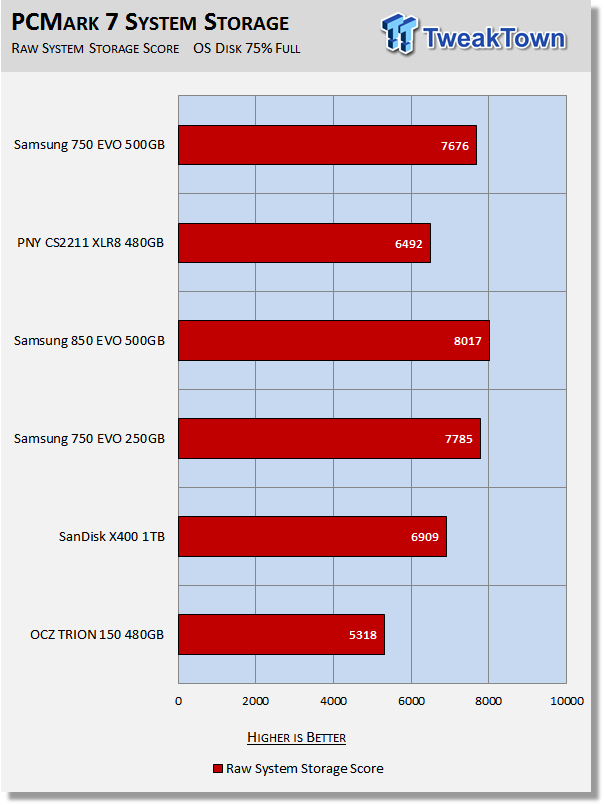
This test serves as a perfect example of why we love Samsung's EVO series SSDs so much. The EVO's deliver outstanding real-world performance that is a cut above the competition. The only SATA SSD that can outperform the EVO's in this testing is Samsung's 850 Pro. Surprisingly, the 250GB 750 EVO delivers slightly better performance than the 500GB model.
PCMark 8 - Storage Bandwidth
Version and / or Patch Used: 2.4.304
We use PCMark 8 Storage benchmark to test the performance of SSDs, with traces recorded from Adobe Creative Suite, Microsoft Office, and a selection of popular games. You can test the system drive or any other recognized storage device, including local external drives. Unlike synthetic storage tests, the PCMark 8 Storage benchmark highlights real-world performance differences between storage devices.
OS Volume 75% Full - Lightly Used


As this test once again demonstrates that Samsung's cost effective EVO series SDDs are capable of delivering massive moderate workload performance. Although not charted, the 750 and 850 EVO's can even outperform the 850 Pro in this particular test.
Benchmarks (Secondary) – Max IOPS, Response & Transfer Rates
Iometer – Maximum IOPS
Version and / or Patch Used: Iometer 2014
We use Iometer to measure high queue depth performance. (No Partition)
Max IOPS Read

Max IOPS Write

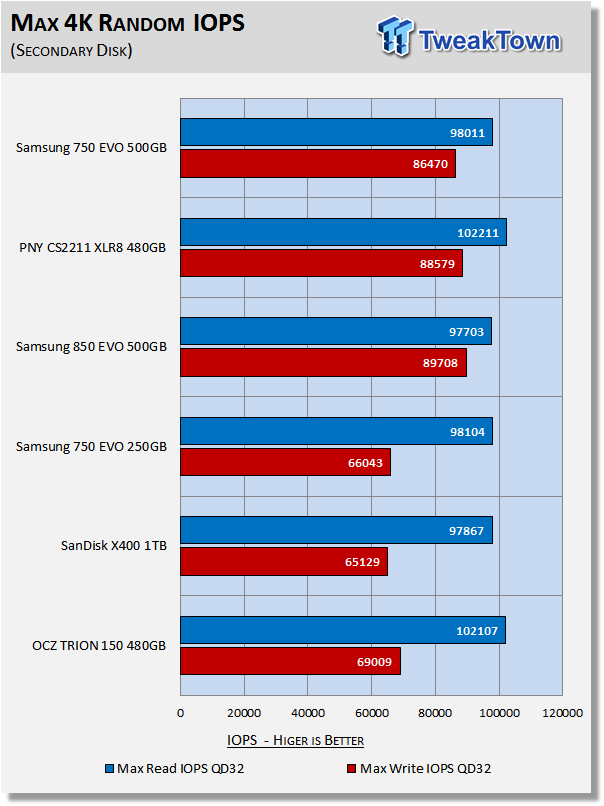
With our configuration, we are able to match Samsung's maximum random read specification of 98,000 IOPS. We are unable to achieve Samsung's 88,000 IOPS maximum write specification. We got close but, didn't quite get there.
Iometer – Disk Response
Version and / or Patch Used: Iometer 2014
We use Iometer to measure disk response times. Disk response times are measured at an industry accepted standard of 4K QD1 for both write and read. Each test runs twice for 30 seconds consecutively, with a 5-second ramp-up before each test. We partition the drive/array as a secondary device for this testing.
Avg. Write Response
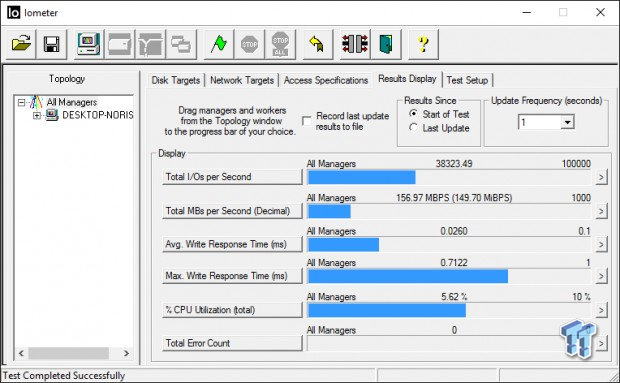
Avg. Read Response


The 500GB 750 EVO delivers the best read response of the drives in our test pool. The 850 EVO delivers the best write response. We have noticed throughout our testing that the 500GB 750 EVO has improved 4K QD1 read performance in comparison to the 250GB 750 EVO.
DiskBench – Transfer Testing
Version and / or Patch Used: 2.6.2.0
We use DiskBench to time a 28.6GB block (9,882 files in 1,247 folders) composed primarily of incompressible sequential and random data as it's transferred from our DC P3700 PCIe NVME SSD to our test drive. We then read from a 6GB zip file that's part of our 28.6GB data block to determine the test drive's read transfer rate. Our system is restarted prior to the read test to clear any cached data, ensuring an accurate test result.
Write Transfer Rate

Read Transfer Rate

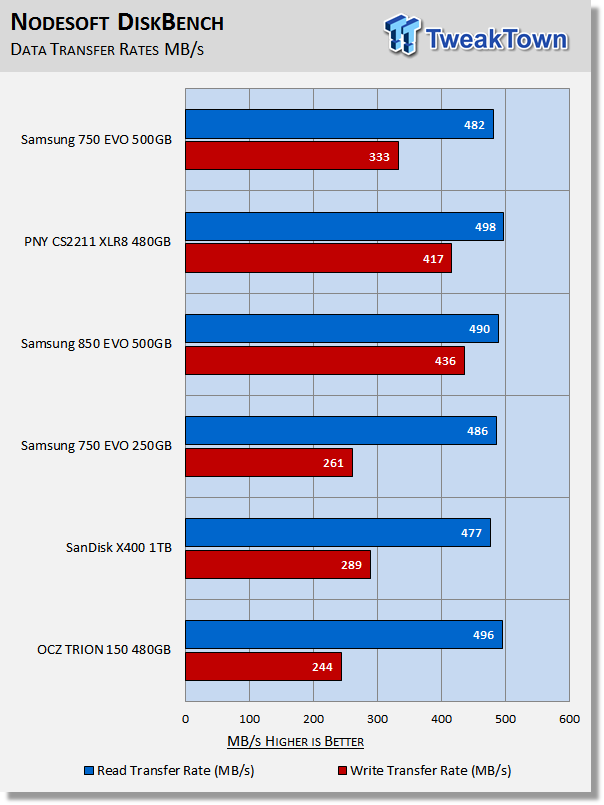
The 500GB 750 EVO sets the bar for planar TLC drives when writing a large block of data. We consider the write portion of this test to be one of the most important considerations when evaluating planar-based TLC SSDs. The 850 EVO wins this test due to the fact that its flash array is comprised of 3D flash. The CS2211 employs an MLC flash array and therefore is able to best the 500GB 750 EVO. Capacity strikes again allowing the 500GB 750 EVO to handily outperform it's smaller sibling. The 500GB 750 EVO handily outperforms the X400 and TRION 150 when writing data.
Benchmarks (Secondary) – PCMark 8 Extended
Futuremark PCMark 8 Extended
Heavy Workload Model
PCMark 8's consistency test simulates an extended duration heavy workload environment. PCMark 8 has built-in, command line executed storage testing. The PCMark 8 Consistency test measures the performance consistency and the degradation tendency of a storage system.
The Storage test workloads are repeated. Between each repetition, the storage system is bombarded with a usage that causes degraded drive performance. In the first part of the test, the cycle continues until a steady degraded level of performance has been reached. (Steady State)
In the second part, the recovery of the system is tested by allowing the system to idle and measuring the performance after 5-minute long intervals. (Internal drive maintenance: Garbage Collection (GC)) The test reports the performance level at the start, the degraded steady-state, and the recovered state, as well as the number of iterations required to reach the degraded state and the recovered state.
We feel Futuremark's Consistency Test is the best test ever devised to show the true performance of solid state storage in an extended duration heavy workload environment. This test takes on average 13 to 17 hours to complete and writes somewhere between 450GB and 14,000GB of test data depending on the drive. If you want to know what an SSDs steady state performance is going to look like during a heavy workload, this test will show you.
Here's a breakdown of Futuremark's Consistency Test:
Precondition phase:
1. Write to the drive sequentially through up to the reported capacity with random data.
2. Write the drive through a second time (to take care of overprovisioning).
Degradation phase:
1. Run writes of random size between 8*512 and 2048*512 bytes on random offsets for 10 minutes.
2. Run performance test (one pass only).
3. Repeat 1 and 2 for 8 times, and on each pass increase the duration of random writes by 5 minutes.
Steady state phase:
1. Run writes of random size between 8*512 and 2048*512 bytes on random offsets for 50 minutes.
2. Run performance test (one pass only).
3. Repeat 1 and 2 for 5 times.
Recovery phase:
1. Idle for 5 minutes.
2. Run performance test (one pass only).
3. Repeat 1 and 2 for 5 times.
Storage Bandwidth
PCMark 8's Consistency test provides a ton of data output that we use to judge a drive's performance.

We consider steady state bandwidth (the blue bar) our test that carries the most weight in ranking a drive/arrays heavy workload performance. Performance after Garbage Collection (GC) (the orange and red bars) is what we consider the second most important consideration when ranking a drive's performance. Trace-based steady state testing is where true high performing SSDs are separated from the rest of the pack.
Samsung's EVO's don't lead the field in this test primarily due to the fact that they have very little overprovisioning. In contrast, the TRION 150 and CS2211 both possess a healthy dose of OP which allows for better on-the-fly internal flash management.

We chart our test subject's storage bandwidth as reported at each of the test's 18 trace iterations. This gives us a good visual perspective of how our test subjects perform as testing progresses. This chart sheds more light on how the drives perform as they progress through the testing phases.
Total Access Time (Latency)
We chart the total time the disk is accessed as reported at each of the test's 18 trace iterations.

Disk Busy Time
Disk Busy Time is how long the disk is busy working. We chart the total time the disk is working as reported at each of the tests 18 trace iterations.

When latency is low, disk busy time is low as well.
Data Written
We measure the total amount of random data that our test drive/array is capable of writing during the degradation phases of the consistency test. Pre-conditioning data is not included in the total. The total combined time that degradation data is written to the drive/array is 470 minutes. This can be very telling. The better a drive/array can process a continuous stream of random data; the more data will be written.

Overprovisioning and write latency are the biggest factors that determine the outcome of this portion of the test. Capacity can have a small impact as well. Again, the EVO's don't do well with this part of the test because they have very little overprovisioning.
Benchmarks (Secondary) - 70/30 Mixed Workload
70/30 Mixed Workload Test (Sledgehammer)
Version and / or Patch Used: Iometer 2014
Heavy Workload Model
This test hammers a drive so hard we've dubbed it "Sledgehammer". Our 70/30 Mixed Workload test is designed to simulate a heavy-duty enthusiast/workstation steady-state environment. We feel that a mix of 70% read/30% write, full random 4K transfers best represents this type of user environment. Our test allows us to see the drive enter into and reach a steady state as the test progresses.
Phase one of the test preconditions the drive for 1 hour with 128K sequential writes. Phase two of the test runs a 70% read/30% write, full random 4K transfer workload on the drive for 1 hour. We log and chart (phase two) IOPS data at 5-second intervals for 1 hour (720 data points). 60 data points = 5 minutes.

What we like about this test is that it reflects reality. Everything lines up, as it should. Consumer drives don't outperform Enterprise-Class SSDs that were designed for enterprise workloads. Consumer drives based on old technology are not outperforming modern Performance-Class SSDs, etc.
The 850 EVO delivers the best overall performance of the drives in our test pool, followed by PNY's CS2211 and then the 500GB 750 EVO. All of the EVO's display far better consistency than the other drives in our test pool.
Maxed-Out Performance (MOP)
This testing is just to see what the drive is capable of in an FOB (Fresh Out of Box) state under optimal conditions. We are utilizing Windows Server 2008 R2 64-bit for this testing. Same Hardware, just an OS change.




Final Thoughts
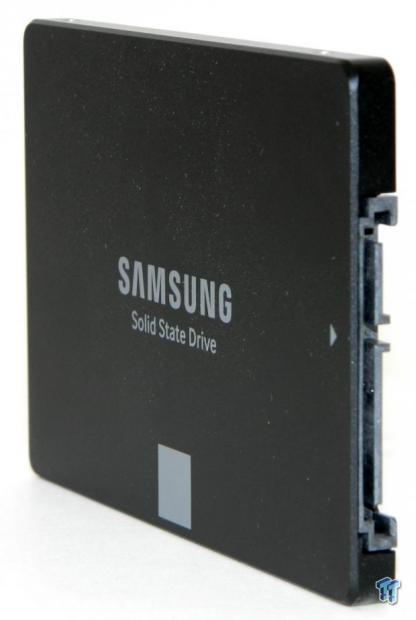
One of the main differentiators for Samsung SSD's from the majority of the competition is that they are complete in-house products. Samsung manufactures all of the major components utilized on their SSDs. This gives Samsung an advantage in production costs, research and development, as well as quality control. Samsung has been offering TLC SSD's for years and not one of them suffers from low performance common to the majority of TLC SSDs on the market. Competing flash manufactures have been much later to board the TLC train, and as such don't offer TLC-based products that are as powerful and refined as what Samsung has to offer. There are lower cost alternatives on the market, but what you save in cost you also lose in the way of performance.
We feel that Samsung's 750 EVO really fills a gap in Samsung's product stack. The 120GB and 240GB 750 EVO's have plenty of performance, class-leading performance, but fell a bit short for users that want more capacity. One of the main drawbacks inherent to planar TLC SSDs has always been and continues to be sustained write performance. The 500GB 750 EVO's superior sustained write performance almost remedies this drawback. It doesn't sustain writes as well as more expensive MLC-based SSDs, or the 850 EVO, but it does deliver the best sustained write transfer rate of any planar-based TLC drive on the market by a large margin.
Samsung's 500GB 750 EVO running as our OS disk delivers a tier-1 SSD experience. Like all of Samsung's SSDs, the 750 EVO is responsive, boots like lightening and handles multi-tasking with ease. We can attribute the outstanding user experience we get from the 750 EVO directly to its superior low queue random performance. For those of you that want even more performance from your 750 EVO, RAPID mode can be enabled provided you are running the drive in AHCI mode.
With a 500GB capacity point and now worldwide availability, Samsung's 750 EVO has a lot to offer at a competitive price point. Samsung's 500GB 750 EVO has earned an Editor's Choice award and a TweakTown recommendation.
Pros:
- Moderate Workload Performance
- RAPID Mode
- Random Read/Write Performance
- Competitive Price Point
Cons:
- Heavy Workload Performance

| Performance | 98% |
| Quality including Design and Build | 98% |
| General Features | 96% |
| Bundle and Packaging | 97% |
| Value for Money | 95% |
| Overall | 97% |
The Bottom Line: At a 500GB capacity point, Samsung's 750 EVO is even more appealing than before. Simply stated, the 500GB 750 EVO is the best performing planar-based TLC SSD on the market.
PRICING: You can find products similar to this one for sale below.
 United
States: Find other tech and computer products like this
over at Amazon.com
United
States: Find other tech and computer products like this
over at Amazon.com
 United
Kingdom: Find other tech and computer products like this
over at Amazon.co.uk
United
Kingdom: Find other tech and computer products like this
over at Amazon.co.uk
 Australia:
Find other tech and computer products like this over at Amazon.com.au
Australia:
Find other tech and computer products like this over at Amazon.com.au
 Canada:
Find other tech and computer products like this over at Amazon.ca
Canada:
Find other tech and computer products like this over at Amazon.ca
 Deutschland:
Finde andere Technik- und Computerprodukte wie dieses auf Amazon.de
Deutschland:
Finde andere Technik- und Computerprodukte wie dieses auf Amazon.de
What's in Jon's PC?
- CPU: AMD Ryzen 7800X 3D
- MOTHERBOARD: GIGABYTE AORUS Master X670E
- RAM: Kingston Fury Renegade 7200MHz 32GB
- GPU: ZOTAC AMP Extreme GeForce RTX 4090
- SSD: Crucial T700 2TB Gen5
- OS: Windows 11 Pro
- COOLER: Lian Li Galahad 360 AIO
- CASE: Lian Li Lancool III
- KEYBOARD: Corsair K65 RGB Mini
- MOUSE: SteelSeries AEROX 5 Wireless
- MONITOR: ASUS ROG Strix PG27AQN 360Hz 1440p ULMB2
Similar Content
Related Tags

